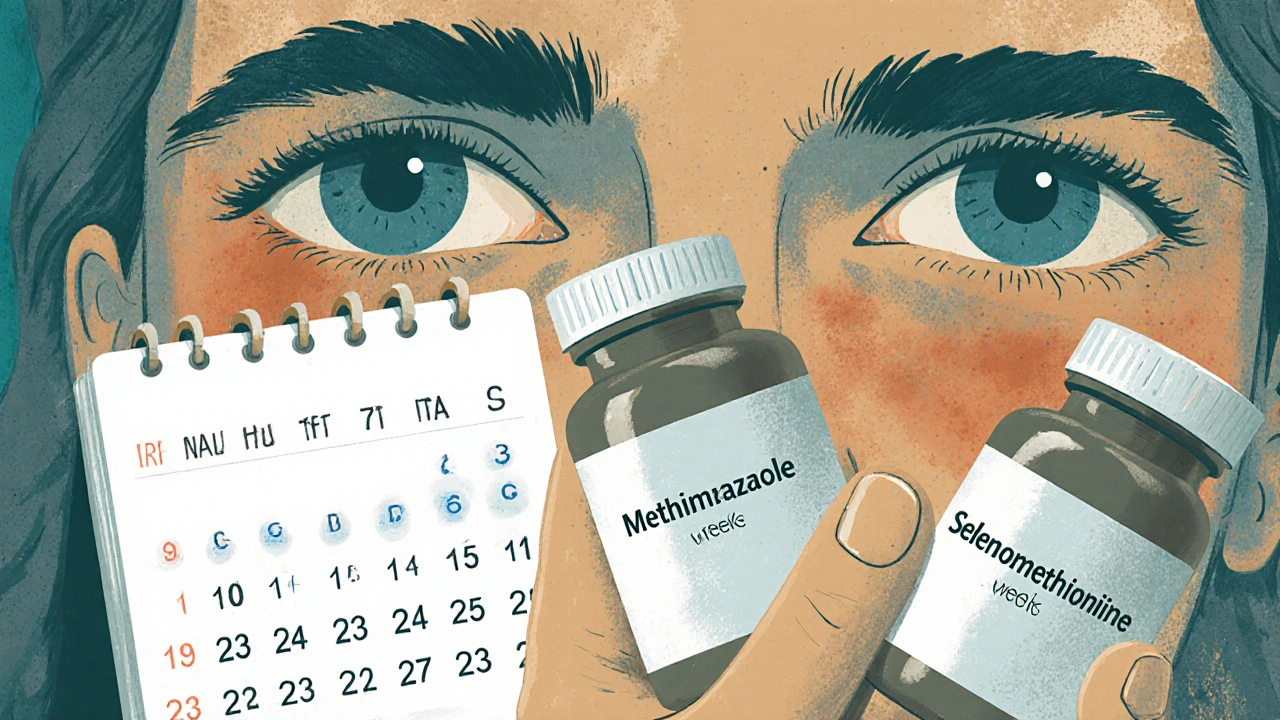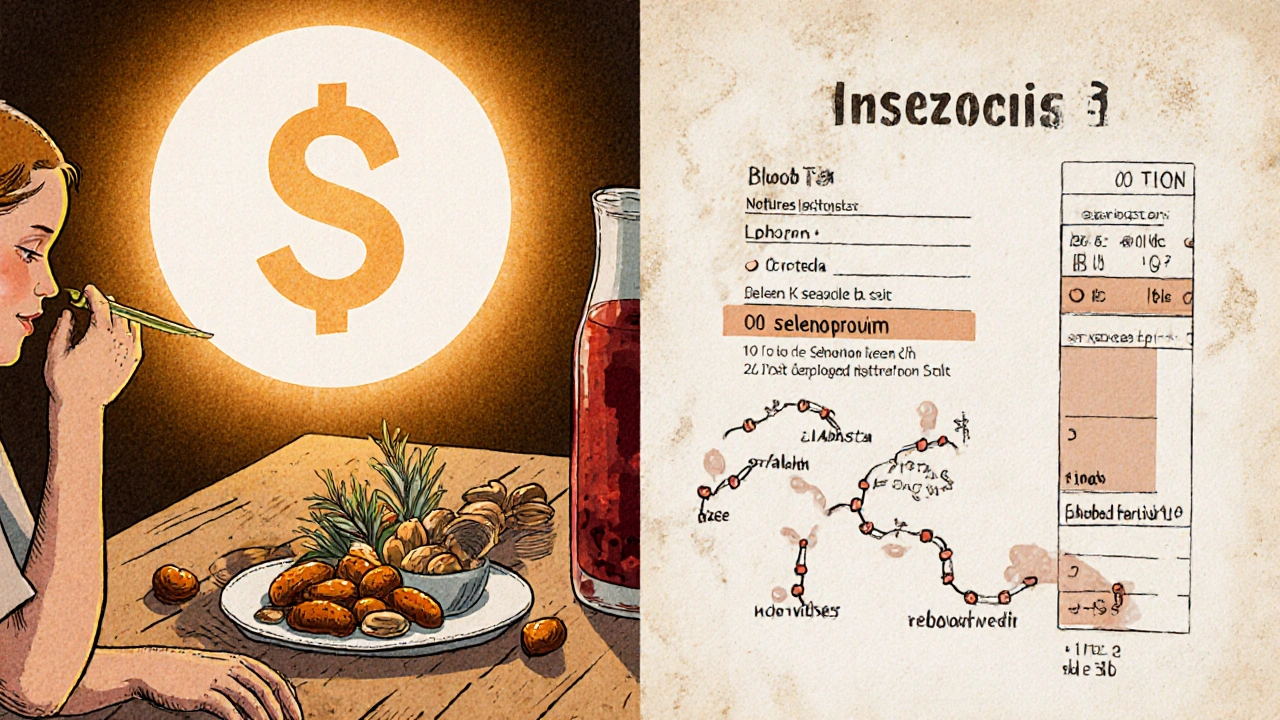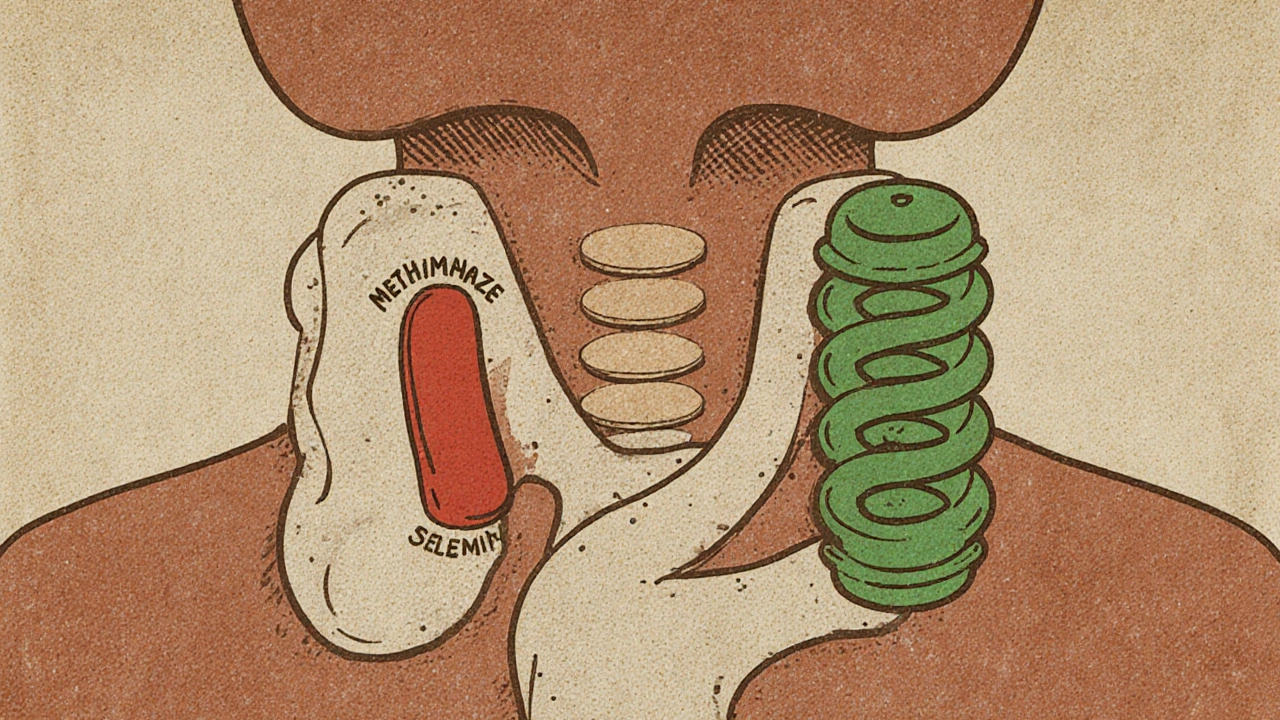When you’re diagnosed with Graves’ disease or another form of hyperthyroidism, your doctor might prescribe methimazole. It’s one of the most common antithyroid drugs used to bring thyroid hormone levels back to normal. But you might also hear about selenium-often mentioned alongside methimazole in research papers and patient forums. Are they meant to be taken together? Does selenium make methimazole work better? Or is it just another supplement people take hoping it helps?
What Methimazole Does and How It Works
Methimazole is a medication that blocks the thyroid gland from making too much hormone. It doesn’t destroy the gland or remove it-it just slows down the production of T3 and T4, the two main thyroid hormones. For most people with Graves’ disease, this is the first-line treatment. It’s taken orally, usually once or twice a day, and many patients see improvement in symptoms like rapid heartbeat, weight loss, and anxiety within a few weeks.
The typical starting dose is 5 to 15 milligrams per day, depending on how high the hormone levels are. Some people stay on it for months; others need it for years. About 30% to 50% of patients go into remission after 12 to 18 months of treatment, meaning they can stop taking it without the thyroid going haywire again. But for others, the disease comes back, and long-term use becomes necessary.
Side effects are usually mild-itchy skin, joint pain, upset stomach. But in rare cases, methimazole can cause serious liver damage or a drop in white blood cells. That’s why regular blood tests are required, especially in the first few months. If you develop a fever, sore throat, or yellowing of the skin, stop taking it and call your doctor right away.
Why Selenium Comes Up in Thyroid Discussions
Selenium is a trace mineral your body needs in tiny amounts. It’s found in Brazil nuts, seafood, eggs, and whole grains. But it’s not just about nutrition. Selenium plays a direct role in how your thyroid functions. It’s part of enzymes called selenoproteins that help convert T4 into the more active T3 hormone. It also protects thyroid cells from damage caused by inflammation and oxidative stress.
In Graves’ disease, the immune system attacks the thyroid, causing swelling and overactivity. This inflammation can lead to eye problems (Graves’ ophthalmopathy) in about half of patients. That’s where selenium enters the picture. Multiple clinical trials have shown that taking 200 micrograms of selenium daily-usually as selenomethionine-can reduce eye swelling, improve quality of life, and slow the progression of eye disease in people with mild to moderate Graves’ ophthalmopathy.
A 2011 study published in The New England Journal of Medicine followed 169 patients with mild thyroid eye disease. Half took selenium daily for six months; the other half took a placebo. The selenium group had significantly less eye inflammation, better eye movement, and improved appearance. The benefits lasted up to 12 months after stopping the supplement.
Can You Take Selenium With Methimazole?
Yes-selenium and methimazole can be taken together safely. There are no known harmful interactions between them. In fact, many endocrinologists recommend combining them, especially if you have eye symptoms. Methimazole controls the overproduction of hormones, while selenium helps calm the immune attack on the thyroid and surrounding tissues.
One 2018 study in Thyroid journal looked at 90 patients with Graves’ disease. All received methimazole. Half also got 200 mcg of selenium daily. After six months, the selenium group had lower levels of thyroid antibodies (TPOAb and TRAb), which are markers of autoimmune activity. Their thyroid function stabilized faster, and fewer patients relapsed after stopping methimazole compared to the group that didn’t take selenium.
This doesn’t mean selenium replaces methimazole. It doesn’t lower thyroid hormone levels on its own. But it supports the body’s healing process while methimazole does its job. Think of it like this: methimazole is the brake pedal. Selenium is the shock absorber-reducing the damage caused by the ride.

Who Should Consider Selenium Supplementation?
Not everyone with hyperthyroidism needs selenium. The strongest evidence supports its use in two groups:
- People with Graves’ disease who have mild to moderate eye symptoms-bulging eyes, redness, pressure, or double vision.
- Those who are positive for thyroid antibodies (TPOAb or TRAb), indicating autoimmune thyroid disease.
If you have no eye problems and your thyroid antibodies are normal, selenium is unlikely to help. There’s no proven benefit for people with toxic nodules or subacute thyroiditis. And if you’re already getting enough selenium from your diet-say, you eat Brazil nuts once a week or seafood regularly-you probably don’t need extra.
Too much selenium can be toxic. The safe upper limit is 400 mcg per day. Taking more than that long-term can cause nausea, hair loss, brittle nails, and nerve damage. Most supplements contain 100-200 mcg. Stick to 200 mcg daily if your doctor recommends it. Avoid mega-doses.
How to Take Selenium Properly
If your doctor says yes to selenium, here’s what you need to know:
- Choose selenomethionine-it’s the most absorbable form and the one used in most studies.
- Take it with a meal. Fat helps your body absorb it better.
- Don’t take it with calcium or iron supplements. They can interfere with absorption. Space them out by at least two hours.
- Stick with 200 mcg per day. More isn’t better.
- Take it for at least six months. Benefits show up slowly.
- Get your selenium levels checked if you’re on it long-term. Some labs offer serum selenium tests.
Also, avoid selenium supplements that contain yeast-based selenium or sodium selenite unless your doctor specifically recommends them. Selenomethionine is the gold standard.
What Happens When You Stop Methimazole?
Many people hope to stop methimazole after a year or two. But relapse is common-up to 70% of patients see their thyroid go hyperactive again. Selenium doesn’t prevent relapse on its own. But when taken with methimazole, it may help reduce the chances.
In the same 2018 study, patients who took selenium along with methimazole had a 30% lower relapse rate after stopping treatment compared to those who only took methimazole. The reason? Lower antibody levels. When your immune system calms down, your thyroid is less likely to go rogue again.
That’s why some doctors now recommend continuing selenium for three to six months after stopping methimazole, especially if your antibodies are still high. It gives your immune system more time to reset.

Common Myths About Methimazole and Selenium
There’s a lot of misinformation online. Here are the facts:
- Myth: Selenium can cure Graves’ disease.
Fact: No supplement can cure autoimmune thyroid disease. It can only reduce symptoms and slow progression. - Myth: You can skip methimazole and just take selenium.
Fact: Selenium doesn’t lower thyroid hormone levels. You still need antithyroid drugs if your levels are high. - Myth: All selenium supplements are the same.
Fact: Selenomethionine works best. Others may not be absorbed well or studied. - Myth: More selenium = faster results.
Fact: Overdosing is dangerous. Stick to 200 mcg.
When to Talk to Your Doctor
Before starting selenium, talk to your doctor if you:
- Have kidney disease or diabetes
- Are pregnant or breastfeeding
- Take blood thinners or immunosuppressants
- Have a history of skin cancer
Selenium is generally safe, but it’s not risk-free. Your doctor can help you decide if it’s right for you based on your antibody levels, eye symptoms, and overall health.
If you’re already on methimazole and your eyes feel worse, or if you’re struggling with fatigue and weight changes despite taking your meds, selenium might be worth exploring. Don’t start it on your own. Get your thyroid antibodies tested first. That’s the real clue.
What to Expect in the First Few Months
When you start selenium with methimazole, you won’t feel a difference right away. It’s not like a painkiller. The benefits build over time.
By week 4-8: You might notice less eye dryness or irritation. Your eyelids may feel less puffy.
By month 3: Your doctor may see a drop in your TRAb levels in blood tests. Your energy might improve, even if your thyroid levels are already normal.
By month 6: If you had eye swelling, you may notice your eyes look less bulging. Your vision may feel clearer. And if you stop methimazole after this point, your chances of staying in remission are higher.
Keep track of your symptoms. Take photos of your eyes every month. Write down how you feel. This helps your doctor see the real impact-not just lab numbers.
Can selenium replace methimazole for treating hyperthyroidism?
No. Selenium does not lower thyroid hormone levels. It helps reduce inflammation and immune activity, but it cannot replace antithyroid medications like methimazole when your T3 and T4 are too high. You need methimazole to control hormone production. Selenium supports the treatment-it doesn’t replace it.
How long should I take selenium with methimazole?
Most studies recommend taking 200 mcg of selenium daily for at least six months. If you have eye symptoms, continuing for 12 months may offer longer-lasting benefits. Some doctors suggest staying on selenium for three to six months after stopping methimazole to help maintain remission, especially if your thyroid antibodies remain elevated.
Is it safe to take selenium long-term?
At 200 mcg per day, selenium is safe for most people for up to two years. The upper safety limit is 400 mcg per day. Long-term use above that can lead to selenium toxicity, which causes hair loss, nail brittleness, nausea, and nerve problems. Stick to the recommended dose and get periodic blood tests if you’re on it for more than a year.
Can I get enough selenium from food instead of supplements?
Yes, but it’s hard to hit 200 mcg consistently through diet alone. One Brazil nut has about 68-91 mcg. You’d need to eat two to three every day. Other sources like tuna, shrimp, and eggs contain much less. For therapeutic effects, especially with Graves’ disease, supplements are more reliable than food.
Does selenium help with weight loss in hyperthyroidism?
Not directly. Weight loss in hyperthyroidism is caused by excess thyroid hormones speeding up your metabolism. Selenium doesn’t lower hormone levels, so it won’t stop the weight loss. Once methimazole brings your hormones back to normal, your weight should stabilize. Selenium may help you feel less fatigued, which could improve your activity level, but it’s not a weight-loss tool.

Julisa Theodore
October 31, 2025 AT 19:25
So let me get this straight-you’re telling me a mineral found in nuts and seafood can somehow outsmart my immune system? Sounds like the thyroid version of a magic bean. I’m not buying it. If selenium was that powerful, why aren’t we all just eating Brazil nuts and calling it a day? No drugs, no labs, no doctors. Just snack time and chill. I call BS.
Lenard Trevino
November 2, 2025 AT 03:11
Look, I’ve been on methimazole for 14 months now, and I swear to god, my eyes went from looking like I’d been punched in the face by a confused owl to… kinda normal. But here’s the kicker-I started selenium at month 6, and honestly? It felt like my body finally stopped screaming. I didn’t just feel better-I felt *heard*. Like my immune system finally took a breath and said, ‘Okay, maybe we don’t have to destroy everything today.’ I cried. Not because I’m weak-because I was tired of being a battlefield. If you’re on the fence, just try it. Six months. No hype. Just science and a little hope.
Paul Maxben
November 3, 2025 AT 03:43
wait so u mean to tell me the pharma companies dont want u to know about selenium?? like they r making billions off methimazole but this lil mineral from brazil nuts is the real fix?? and they dont want u to know?? this is so obvious im crying. why dont u just go to walmart and buy a bottle of selenomethionine instead of letting them pump u full of chemicals?? its 200 mcg not 200 mg jfc. they dont want u healthy they want u addicted. #seleniumisfreedom
Molly Britt
November 4, 2025 AT 21:20
They’re hiding the truth. Selenium reduces antibodies? That’s not science-that’s a cover-up for the real cure: electromagnetic frequency suppression. Your thyroid is being targeted by 5G towers and Big Pharma knows it. They sell you methimazole to keep you docile while they fry your pineal gland. Take selenium if you want, but also buy a Faraday cage. And stop trusting doctors-they’re paid by the iodine lobby.
Nick Cd
November 5, 2025 AT 18:10
im not saying this is a conspiracy but why does everyone act like selenium is some miracle pill when its literally just a trace element that was discovered in 1817 and weve been eating it in nuts for centuries?? why now?? why with methimazole?? why not just fix the gut?? why not remove gluten?? why not detox the liver?? why not sleep 8 hours?? why not cry more?? why not hug a tree?? i think the real issue is weve forgotten how to be human anymore and now we need a pill for everything even our immune system needs a babysitter
Patricia Roberts
November 6, 2025 AT 14:40
Oh wow. A 2018 study? In Thyroid? How quaint. Next you’ll tell me the moon landing was real and gravity isn’t just a suggestion. I mean, I’m sure the journal was peer-reviewed by the same people who think ‘organic’ means ‘not secretly made by Monsanto.’ But hey, if you wanna spend $15 a month on a supplement that does nothing but make your urine smell like garlic, go ahead. I’ll be over here eating my three Brazil nuts and ignoring the fact that my thyroid has been fine since I stopped worrying about it.
Adrian Clark
November 7, 2025 AT 05:10
Let me get this straight-you’re telling me a mineral can reduce autoimmune damage, but we’re still supposed to take a drug that can fry your liver? That’s not medicine, that’s a hostage negotiation. Methimazole is the guy holding the gun. Selenium is the therapist whispering, ‘It’s gonna be okay.’ But who’s paying for therapy? Not the insurance company. They want you on methimazole forever. So yeah, take selenium. But don’t be surprised when your doctor acts like you just asked for a unicorn prescription.
Rob Giuffria
November 8, 2025 AT 04:02
It’s not about selenium or methimazole-it’s about control. We’ve turned our bodies into machines that need software updates. You’re not sick-you’re out of sync. The thyroid isn’t broken; it’s screaming for rest, for peace, for a damn vacation from stress, sugar, and silence. Selenium might help. But so will quitting social media. So will sleeping in darkness. So will saying no. You want to heal? Stop trying to fix your thyroid and start fixing your life. The rest is just noise.
Barnabas Lautenschlage
November 8, 2025 AT 18:50
I’ve read the studies, checked the meta-analyses, and talked to three endocrinologists. The evidence for selenium in Graves’ ophthalmopathy is solid-especially for selenomethionine at 200 mcg/day. It’s not a cure, but it’s one of the few adjunct therapies with reproducible results. The antibody reduction in the 2018 trial was statistically significant, and the safety profile is excellent within recommended doses. That said, dietary selenium varies wildly by region, and most people in the U.S. aren’t deficient. If you have eye symptoms and positive antibodies, it’s worth a trial. If not, skip it. No need for drama. Just data.
Ryan Argante
November 9, 2025 AT 04:21
While the clinical data supporting selenium supplementation in Graves’ disease is compelling, particularly for patients with mild-to-moderate ophthalmopathy, it remains an adjunctive therapy-not a replacement for conventional pharmacologic intervention. The 2011 NEJM and 2018 Thyroid studies provide Level I evidence for its immunomodulatory effects, yet the mechanism remains incompletely understood. I would advise patients to confirm baseline selenium status via serum testing, prioritize selenomethionine, and maintain consistent communication with their care team. Avoid self-prescribing. Medicine is not a buffet.
Jeanette Case
November 10, 2025 AT 20:50
JUST TOOK MY FIRST 200 MCG OF SELENIUM TODAY AND MY EYES ALREADY FEEL LESS STUCK 😭 I’VE BEEN ON METHIMAZOLE FOR 9 MONTHS AND THIS IS THE FIRST TIME I’VE FELT LIKE MY BODY IS HEALING NOT JUST SURVIVING 🙏 I’M TAKING IT WITH LUNCH AND I’VE BEEN EATING 2 BRAZIL NUTS DAILY TOO-YEAH I KNOW THAT’S OVERDOSE BUT I CAN’T HELP IT 😅 I’LL UPDATE IN 3 MONTHS IF I’M STILL NOT BLIND 🤞 #seleniummagic #thyroidwarrior
Leonard Buttons
November 12, 2025 AT 20:36
My doc put me on selenium after my TRAb stayed high even after TSH normalized. Took it for 8 months. Saw my antibody levels drop 40%. No side effects. Didn’t feel any different, but the numbers mattered. I ate a few Brazil nuts, but honestly? The pill was easier. Don’t overthink it. If your doctor says it’s right for you, do it. If not, don’t stress. It’s not magic, it’s just science with a nice label.